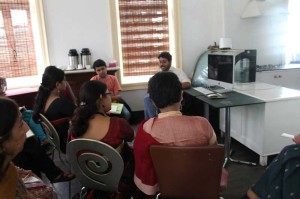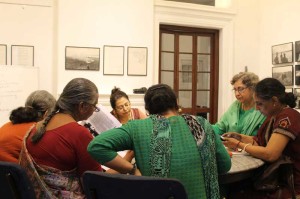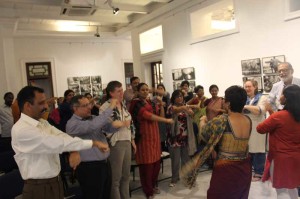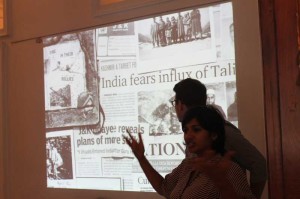Contemporary History and the Classroom. Workshop by Abeer Gupta
There we were, on the afternoon 1st of August, sitting in a cosy circle around Abeer Gupta, Assistant Professor at the School of Design, Ambedkar University, slightly unsure of what to expect of the workshop we were attending. I for one was apprehending a deluge of sophisticated concepts and complicated jargon that I would struggle to wrap my brains around. Instead, for the next couple of hours, we launched into a discussion about the persistent presence of history in our lives and the articulation of the past through design, using as our lens the various projects he has worked on. The notion of representation through various mediums and the importance of renarrativisation of space was our primary concern.
Professor Gupta had established at the beginning that his perspective was not that of a trained historian but that of a person who had procured his sense of history while on the job. As one of the developers of the Srinagar Walk in Kashmir, Professor Gupta attempted to bring the history of Downtown Srinagar alive through the inhabitants of the area and their stories. This project was conceptualised to enable the inhabitants of the area to use their own space and their own histories to establish themselves as entrepreneurs in the tourism industry. Their narratives, the stories of many people, would be employed to contextualise the space for tourists, the perpetual outsiders. The walks thus incorporated and validated not just the oral histories of the inhabitants but also acknowledged the multiplicity of voices and their varying histories. In deriving the agency of oral histories, it is important, pointed out Professor Gupta, that we consider where and how an individual places himself both in a political space and time, for no space is devoid of the presence and influence of the latter. It emerged to us that the two strands of thought that had been frequently raised, discussed and debated over in the past two days of the conference—the establishment of oral narratives and acknowledgement of multiplicity in history—had been actually employed in this project for economical effect.
As the discussion veered towards Professor Gupta’s experience of curating an exhibition on the life of Dr Karan Singh in Kashmir, we realigned our thoughts to consider the museum as a political space. As a limited space of authority, the museum becomes a contested space—every element that finds itself within that space becomes representative of a history that the curator chooses to tell his audience. The arrangement of the material dictates the chronological order of viewing and thus the unfolding of the narrative. The words which are employed to describe the material, if words find a place at all, have a politics of their own—the structuring of every sentence influences the narrative. Each word has to be carefully picked and delicately strung together to fuse together the intended narrative. Unbeknownst to the viewer, hours are spent mulling over the word that will serve the exact purpose in a sentence. Even greater is the politics of the language used in the presentation—the subtle nuances of any language tends to get lost in translation and the ideal language changes with every socio-politico- cultural environment. Thus the curator of a historic photographic archive, in performing every step of his work, essentially appropriates history.
In explaining the nuances of documentary film making Professor Gupta shared clips of a documentary made by him on the Muslim inhabitants of Ladakh and Leh and their historical significance. The film is a montage of his personal collection of still images, ranging from sketches made by British cartographers to photographs that he had taken and motion pictures along with oral narratives of the local people. Woven in through the narrative are the local accounts of the parallel flourishing of the religions of Islam and Buddhism in the area, the historical trade routes of the region, the story of the first merchant who had set up business in the bazaar, among others. The most interesting aspect of the documentary were the sketches and stills used in the film, each of which had multiple narratives within themselves. The opening shot, for example, is a sketch by a British cartographer. It is not a map but a scale of the landscape of the Ladakh. A perfunctory look reveals only a sketch of a busy bazaar with mountains as a backdrop. Closer scrutiny reveals the palace nestled on the mountains as well as the lake which allowed the inhabitants of the palace to survive. One can also see the tower of victory that the Ladakhis had constructed on the highest point of the valley, over the buried skulls of the vanquished Hores, a reminder of the only war the Ladakhis had ever won. Incidentally, that tower now functions as a monastery. The very next sketch is that of the central bazaar and the third a close up of the mosque at the centre of that bazaar. The narrative thus subtely indicates the presence of Islam in Ladakh to the audience and establishes the film’s intent. Another interesting aspect of the film is the text that punctuates the images, offering an explanation of the unfamiliar objects without the film appearing didactic in any form. It’s a subtle dance of influencing the audience while allowing them to explore their own interpretation of the material.
The filmmaker, in a sense, is a curator of ideas and every film an exhibition.
As the workshop came to a close we realised that we had gained not only an understanding that history can be accessed through tourism, museum culture and documentaries but also snippets of information about the location of Asia’s longest village, which happens to be a Muslim congregation, the politics behind and the process of building the historical Jama Masjid of Kashmir, the reimagining of a religion originating on arid plains by believers of a mountainous terrain and such through the course of our discussion without any of it being our immediate concern. Somehow, through the course of the discussion, all this information had percolated in our brains. At the end of the workshop, we came away with much more than any of us had bargained for.
-Anushka Halder
Role of Literature as an Alternative Narrative. Workshop by Anjum Katyal and Dr. Kavita Punjabi
The workshop was conducted in two halves, with the two resource persons taking one half each, to look at the role of literature as an alternative narrative in two very different ways.
Anjum Katyal began by listing the words that came to the minds of the participants first when they thought of history and then literature. It was found that there are many words that were common to both like story, narrative, humanity etc. Then she asked the participants to focus on the Revolt of 1857 and select a piece of literature, which could be used while teaching this topic in the history classroom.
Dr. Kavita Punjabi introduced the participants to three very powerful genres in literature, which lend themselves to the study of history. The first was ‘testimonio’ or testimonials, which record the history of an entire community or movement. The second was a beautiful piece of love poetry by Faiz, which is actually a metaphor for Pakistan and Bangladesh following 1971. And the third was the deliberate fictionalising of an event too traumatic to be studied from just the factual historical perspective.e.g. Lajwanti by Rajinder Singh Bedi and Toba Tek Singh by Saadat Hasan Manto.
– Sunita Biswas
Storyfying the Curriculum. Workshop by Deeptha Vivekanand and Nisha Abdulla
The workshop was right after lunch so we were all feeling quite lethargic. Deeptha and Nisha made us enact whatever they were saying so that we’d feel more energetic! It was rather comical, for me, to watch everyone in the audience (most of whom were well above age forty) making monkey faces at each other!
Nisha explained to us that schools in Bangalore have a half-day every Saturday. So, storytellers like Deeptha and herself are often called on this day so that they can liven an exceptionally boring chapter in class. They told us that they generally work with the junior and middle schools and ‘storify’ a variety of subjects ranging from English to Math; sometimes introducing a topic, which is covered by more than one department. One such example was the Indus Valley Civilization, which was introduced in the sixth grade. Here, Deeptha made them enact the entire chapter in the form of a story that not only focused on history, but on geography (where the civilization was located, agriculture, trade, etc.) and the sciences (what kind of metals were used and how they were made).
Next, we enacted a ‘pourquoi’ story, which Deeptha explained is an origin story in the form of a fictional or mythological narrative. The word ‘pourquoi’ is French for ‘why’. Deeptha called upon volunteers to enact this story while she narrated it. This story was a Red Indian narrative about how fire was created. Here she explained why deer have such a short tail and why the squirrel has stripes, among other animals.
This was followed by a poem of a Native American folklore on how early man discovered different human civilizations and was shocked to discover that there were other people out there. Deeptha used this in a school where they were beginning the history syllabus with the ‘Evolution of Man’. We were all curious about the images used in the narrative. A teacher pointed out that during the poem there was not a single reference made to a woman! Deeptha assured us that this was the same reaction within a group of eleven year olds who also asked her why there were no women in the poem. Was it because women were non-existent during that time? No, but women weren’t considered important enough to be included in folk tales and legends.
Nisha took over the second half of the session where she spoke about her experience with middle school children when she was telling a story using the backdrop of the French Revolution or the Rise of Nazi Germany. She showed us a couple of video clippings from YouTube, which inspired her to get her students to stage a play and enact a battle scene like the Storming of the Bastille. Along with this she showed us how students wrote autobiographies from both sides and put themselves in the shoes of both the tyrants and the revolutionists. It was lovely to see such a fresh perspective to the revolution that was captured with such creativity by seventh graders. Nisha also told us about another assignment where she made her students write an account of what they think might have transpired if Martin Luther King met Hitler in the after life!
Following this, there was a general discussion where we asked Deeptha and Nisha what would be their take on tackling dull topics in the syllabus, especially when dealing with civics which is mostly about facts and can hardly be ‘storyfied’. Nisha suggested that the parliament could be enacted in class so that everyone was able to see for themselves the proceedings taking place and the structure and composition of the various committees. The importance of storytelling and creativity in the classroom was also discussed, since in this day and age it is all about visual learning as opposed to rote learning. The workshop was scintillating and the discussion proceeded with much exuberance where ideas and pedagogy were exchanged.
– Nayantara Biswas
Photography and History. Workshop by Alisha Sett and Nathaniel Brunt
This workshop started off with introductions by the facilitators. Alisha and Nathaniel told us a little about their work and the Kashmir Photo collective (a digital archive which focuses on the various photographic and oral histories of the Kashmir Valley). The goal of the project is to essentially create a space to learn about Kashmir through multiple perspectives and the process used is to collect family, institutional and regional histories through photographs and interviews.
The next step was introductions from the participants. Do they use photographs in the classroom? If yes, how? And in what context?
The facilitators showed the group a sequence of images without taglines, challenging the participants to unearth the story behind the images. This was a really powerful tool as it made the participants understand the power of photographs and made them think of the reasons behind the photographers choice of frames, subject, angles etc.
The workshop then led to an exercise where participants were divided into groups of 4-5 and given 15 photos of the Bangladesh Liberation War. The task was to act as editors of a popular Indian newspaper and choose any 5 photos that they would feature in their newspaper on the anniversary of the Bangladesh war.
The workshop helped teachers understand how photographs can be used in a powerful way to engage students, build on their skills of analysis despite the limited time teachers get with their students.
– Ayushi Sethia




